
Strong Australian residential demand for electricity continues
Australia's residential sector leads the electricity consumption growth in 2008-09, with a 3.5 percent rise from the previous year.
According to the latest statistical data released by the Energy Supply Association of Australia, the biggest increases in electricity consumption were seen in the Northern Territory, with 4.8 percent, Western Australia with 4.3 percent and Queensland with 3.8 percent.
"The rising trend in residential energy consumption suggests that Australians are continuing their strong uptake of energy-intensive items such as air conditioners and electronic goods, which are a big part of the modern lifestyle today," said Energy Supply Association of Australia Chief Executive Officer Brad Page.
"Alongside the general increase in electricity usage, we have also witnessed another increase in peak electricity use in 2008-09 – recorded as maximum summer and winter power demand levels – following on from increases in the past two years," he said.
Responding to increasing electricity demand levels, Australia's principal electricity generation capacity rose by 4.7 percent in 2008-09, with 83 percent of the new capacity comprising gas-fired generation. Since June 2009, an additional 1,083 MW of gas-fired plant has been commissioned, and a further 4,762 MW is either under construction or in advanced planning.
Australia's wind-powered energy capacity has also increased, with almost 666 MW of additional wind capacity commissioned in 2008-09 – a rise of 63.5 percent. A further 57 MW of wind energy has been commissioned since December 2009 and another 1,592 MW is well advanced.
"More than 3,444 MW of new capacity is under advanced planning to meet growing demand over the next five years, with further substantial new capacity also being considered," said Mr Page.
"Electricity demand growth is underpinning the construction of new electricity generation – which is principally gas plant and wind energy, confirming that the industry is moving down the lower emission path," he said.
"However, a bipartisan commitment to a stable, efficient and long-term carbon emission abatement policy is necessary for Australia’s energy suppliers to transition to a low emission energy supply system."
Australia’s electricity supply industry contributed $17.2 billion to Australia’s gross domestic product, an increase of 7.2 percent compared to 2007-08. In 2008-09, the downstream gas industry contributed $1.9 billion to Australia’s GDP, a 1.7 percent increase.













 Advertise
Advertise











